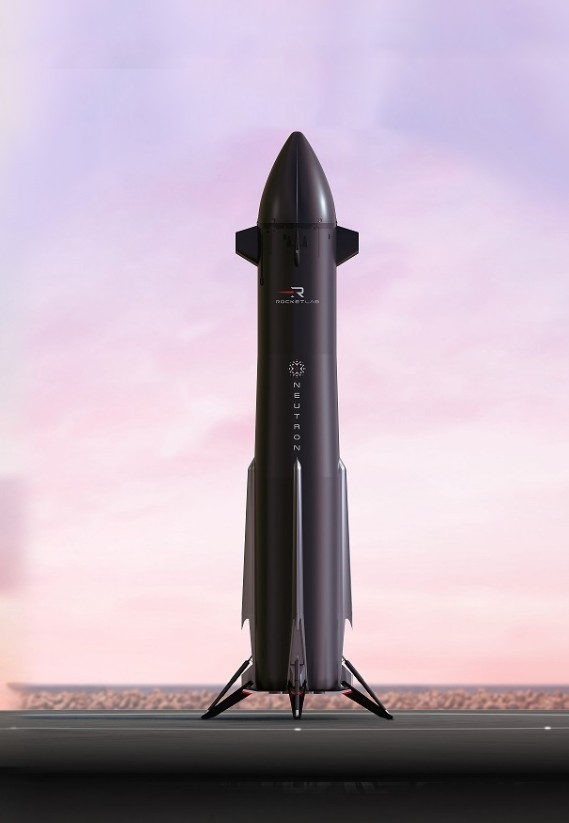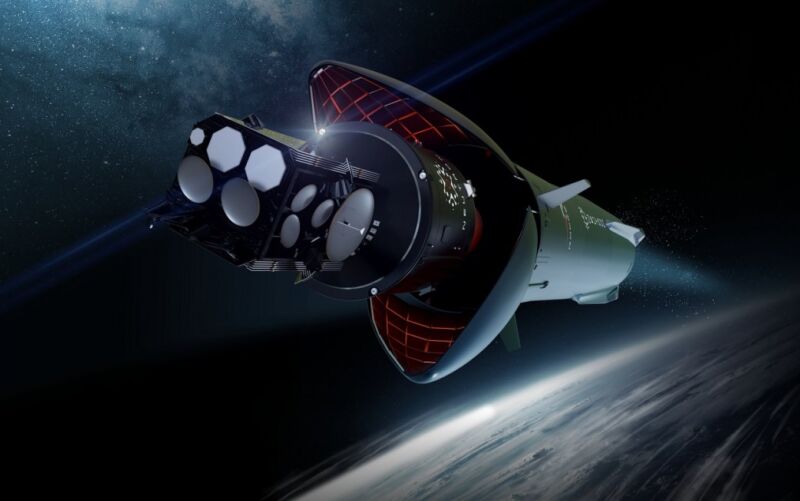Rocket Lab is having a pretty good year with a rising stock price and reaching a monthly launch cadence with its Electron vehicle for the first time. But as ever in the space business, the focus is not so much on what a company has done but what it will do. And for Rocket Lab, its future in the launch business lies with the medium-lift Neutron vehicle.
Recently, the company released an updated rendering of the rocket. It shows a slightly sleeker version of Neutron, with a more pointy nose, fins nearer to the top of the rocket, and much broader landing legs. To understand these design changes, Ars spoke with the chief executive of Rocket Lab, Peter Beck.
Asked about Neutron's snappy new design, Beck quipped, "The lesson we’ve learned here is that people take our renders far more seriously than we take our renders," he said. However, with that said, the changes highlight some important aspects about Neutron.
Wider landing legs
One notable difference is that the rocket's landing legs are now more widely splayed from the bottom. This is because the company now anticipates landing the vehicle down range, on a barge, more often than originally intended.
"In a utopian state, you would always return to the launch site because you don't have the challenge of landing on a barge or the transit time back," Beck said. "So that was where we focused our efforts at. But people really want to use that extra capacity."
READ MORE
- Rocket Lab says Venus mission delay a 'business' decision
- New Zealander without college degree couldn’t talk his way into NASA and Boeing—so he built a $1.8 billion rocket company
- Cyclone Gabrielle: Rocket Lab lines up chopper missions for Mahia locals
- Rocket Lab to fire up first tests of new engine next year
Neutron can deliver 8 metric tons into low-Earth orbit if the booster returns to the launch site, 13 tons with a down-range landing, and 15 tons in fully expendable mode. Beck said that 13 tons seems to be a sweet spot in what customers are looking for, so the company has prioritized sea-based landings. The new legs reflect the need to deal with the pitch and heave of a barge landing.
Upper-stage changes
The new design also has a pointier upper stage with higher grid fins. Beck said grid fin placement results from analyzing and refining the vehicle's aerodynamics, and that it provides more control and better accuracy.
Rocket Lab engineers have also put a lot of work into the upper stage, including the methane and liquid oxygen propellant tanks. The upper stage is not reusable, so the goal is to design a low-cost stage. But at the same time, it also must be high-performing because every kilogram of mass expended on the upper-stage structure is a kilogram of payload lost.
Beck said Rocket Lab will soon begin qualification tests of the upper-stage tank at its facilities in New Zealand, followed by a destructive test. The goal is to complete these tests this year and provide the team confidence in its design—or force a rethink by the developers.

The Archimedean spiral
Another big development project is the closed-cycle Archimedes rocket engine. Nine of these will provide 1.53 million pounds of thrust at liftoff (6,800 kN) with a vacuum-optimized version of Archimedes in the upper stage. This is a significantly larger engine than Rocket Lab has built before, but Beck said that for the industry, it is modestly sized, and rather than aiming for high performance, the design team has pushed for robustness and reliability to support 10 to 20 first-stage flights.
"Engines are always a challenge," he said. "We’ve done the very best to put all of the stress out of the engine."
The company plans to test its Archimedes engines at NASA's Stennis Space Center in Mississippi, and Beck said lots of "infrastructure" work is presently being done there to ready the facilities.
"We don’t believe in signing janky, fake contracts,"
The Neutron program has also benefited from the frequent flights of the smaller Electron. Every rocket that comes back from space carries various test materials and technologies, providing information that is fed into Neutron's design.
“We’re testing every time we fly," Beck said. "So, you know, Electron has just been a fantastic testbed for Neutron. It's like, hey, let's try this new TPS material. Maybe it'll work; maybe it won't. It looks like it should work. What's it going to do in that plasma environment? I'll just stick it on."
Neutron when?
Rocket Lab is still working toward a 2024 launch date, but Beck is realistic about the potential for delays, especially with the upcoming second-stage tank tests and development work to complete on the Archimedes engine.
"The schedule says we can get there," he said. "The rubber is going to hit the road in the next six months after we get some of these big tests under our belt. We are certainly going to try to have something on the launch pad in 2024, but you know, it’s a rocket program."
Beck also isn't rushing out to sign memorandum-of-understandings or contingency-based launch contracts for Neutron. He believes that, given the scarcity of medium-lift launch capacity in the Western world, that when Neutron arrives on the scene, it will be in great demand. (If Neutron can start providing commercial service in the middle of the 2020s, he's very probably not wrong). Initial pricing will be $50 to $55 million per launch.
"We don’t believe in signing janky, fake contracts," Beck said. "Our view here is that we're going to bring a vehicle to market at a time where launch is going to be very constrained. Most people we talk to about Neutron aren't looking to buy one launch, they're looking to buy years of launch. So we need to make sure that they're going to be there. They need to make sure that we're going to be there. And I just see zero point in signing non-real agreements at hugely discounted prices before the product exists."




